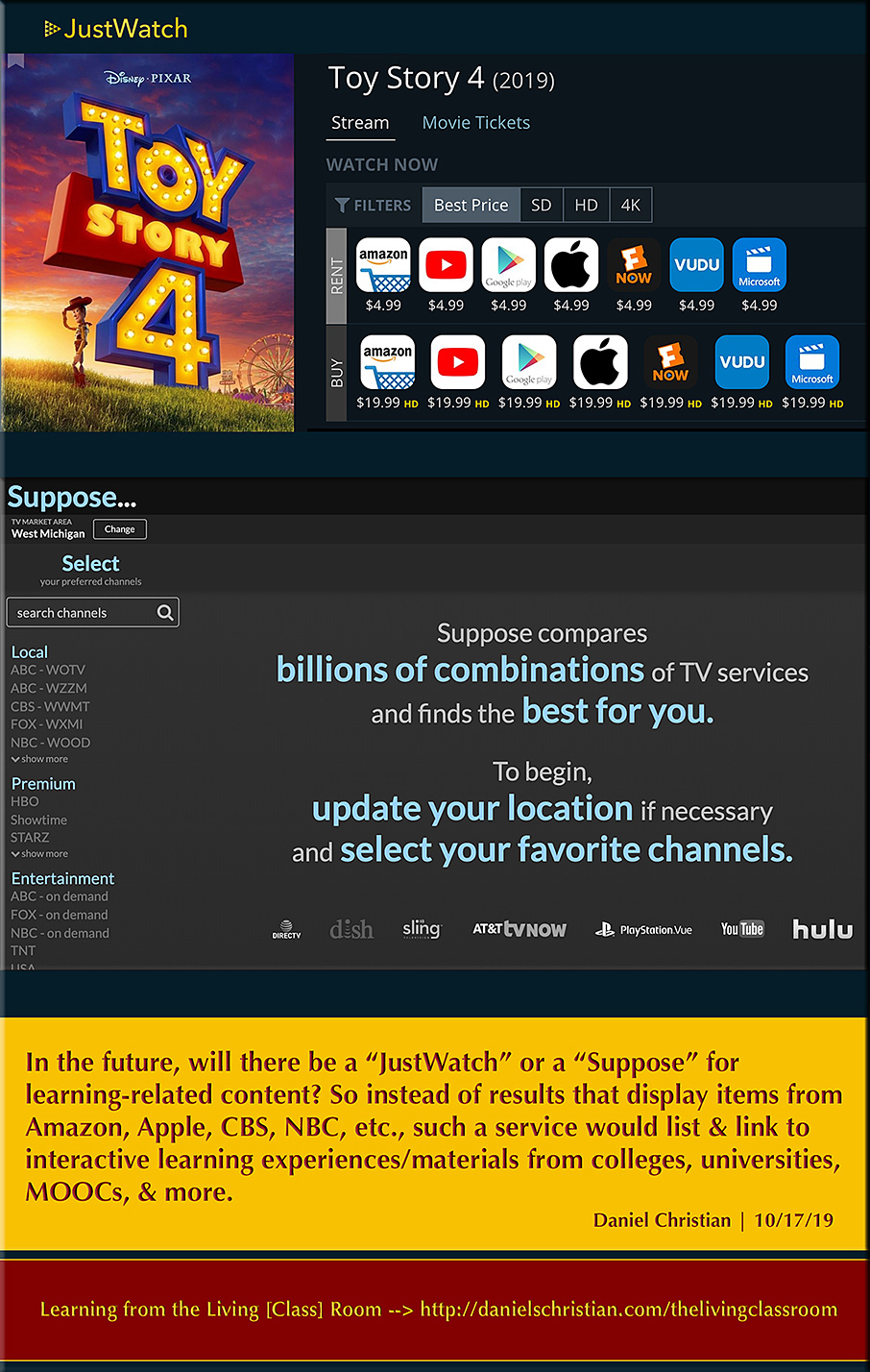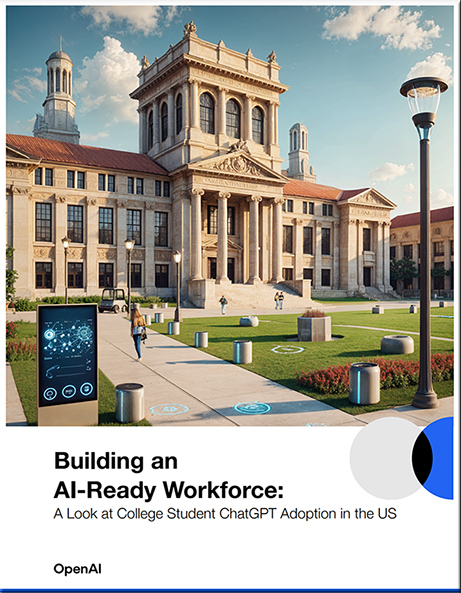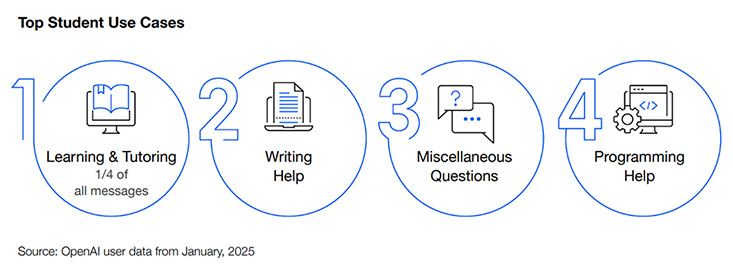Last updated on 2/25/25
A powerful, global, Artificial Intelligence (AI)-based, next-generation, lifelong learning platform -- meant to help people reinvent themselves quickly, safely, cost-effectively, conveniently, and consistently. And speaking of people, this new platform will require -- and will rely upon -- human beings to create it as well as to drive its effectiveness.






In the future, the lifelong ownership of the learning-related records and credentials will belong to the individual learners themselves. They will be the ones who control who else can access these records.
The learners profiles will be stocked by traditional institutions of higher education, corporate training/L&D groups, vendors like LinkedIn Learning, as well as by MOOCs, bootcamps, industry experts, apprenticeships/internships, and others.
Some recent items/quotes/ideas to consider:
Building an AI-Ready Workforce: A look at College Student ChatGPT Adoption in the US — from cdn.openai.com
More than any other use case, more than any other kind of user, college-aged young adults in the US are embracing ChatGPT, and they’re doing so to learn. Over one-third of 18- to 24-year-olds in the US use ChatGPT, and among these users, over one-quarter of their messages are about learning, tutoring, and school work, according to OpenAI user data. A new analysis of OpenAI user data and student survey results reveal the degree to which college-aged students are using ChatGPT across the 50 US states, and where gaps in adoption exist. Our survey finds that three in four college-aged users want to use AI in their education and careers. Beneath these nationwide rates of college-aged user adoption, however, lie challenges that America needs to address in order to foster a healthy economy and ensure future economic competitiveness. As employers increasingly prefer candidates with AI skills, state-by-state differences in student AI adoption creates potential gaps in future workforce productivity and economic development. With many employers prioritizing workers with AI knowledge, states with low rates of AI adoption risk falling behind.
One finding from our student survey that stood out to us: Many college and university students are teaching themselves and their friends about AI without waiting for their institutions to provide formal AI education or clear policies about the technology’s use. The education ecosystem is in an important moment of exploration and learning, but the rapid adoption by students across the country who haven’t received formalized instruction in how and when to use the technology creates disparities in AI access and knowledge.
The enclosed snapshot of how young people are using ChatGPT provides insight into the state of AI use among America’s college-aged students. We also include actionable proposals to help address adoption gaps. We hope these insights and proposals can inform research and policy conversation across the nation’s education ecosystem about how to achieve outcomes that support our students, our workforce, and the economy. By improving literacy, expanding access, and implementing clear policies, policymakers and educators can better integrate AI into our educational infrastructure and ensure that our workforce is ready to both sustain and benefit from our future with AI.
Leah Belsky | Vice President, Education | OpenAI
A multi-year history of how we got here
(i.e., relevant postings/pieces of the puzzle) >>
What does the vision entail?
- A new, global, collaborative learning platform that offers more choice, more control to learners of all ages – 24x7 – and could become the organization that futurist Thomas Frey discusses here with Business Insider:
- A learner-centered platform that is enabled by – and reliant upon – human beings but is backed up by a powerful suite of technologies that work together in order to help people reinvent themselves quickly, conveniently, and extremely cost-effectively
- A customizable learning environment that will offer up-to-date streams of regularly curated content (i.e., microlearning) as well as engaging learning experiences
- Along these lines, a lifelong learner can opt to receive an RSS feed on a particular topic until they master that concept; periodic quizzes (i.e., spaced repetition) determine that mastery. Once mastered, the system will ask the learner as to whether they still want to receive that particular stream of content or not.
- A Netflix-like interface to peruse and select plugins to extend the functionality of the core product
- An AI-backed system of analyzing employment trends and opportunities will highlight those courses and “streams of content” that will help someone obtain the most in-demand skills
- A system that tracks learning and, via Blockchain-based technologies, feeds all completed learning modules/courses into learners’ web-based learner profiles
- A learning platform that provides customized, personalized recommendation lists – based upon the learner’s goals
- A platform that delivers customized, personalized learning within a self-directed course (meant for those content creators who want to deliver more sophisticated courses/modules while moving people through the relevant Zones of Proximal Development)
- Notifications and/or inspirational quotes will be available upon request to help provide motivation, encouragement, and accountability – helping learners establish habits of continual, lifelong-based learning
- An online-based marketplace, matching learners with resources
"I've been predicting that by 2030 the largest company on the internet is going to be an education-based company that we haven't heard of yet," Frey, the senior futurist at the DaVinci Institute think tank, tells Business Insider.
Ideally, the learner is using two displays simultaneously:
While basic courses will be accessible via mobile devices, the optimal learning experience will leverage two or more displays/devices. So while smaller smartphones, laptops, and/or desktop workstations will be used to communicate synchronously or asynchronously with other learners, the larger displays will deliver an excellent learning environment for times when there is:
- A Subject Matter Expert (SME) giving a talk or making a presentation on any given topic
- A need to display multiple things going on at once, such as:
- The SME(s)
- An application or multiple applications that the SME(s) are using
- Content/resources that learners are submitting in real-time (think Bluescape, T1V, Prysm, other)
- The ability to annotate on top of the application(s) and point to things w/in the app(s)
- Media being used to support the presentation such as pictures, graphics, graphs, videos, simulations, animations, audio, links to other resources, GPS coordinates for an app such as Google Earth, other
- Other attendees (think Google Hangouts, Skype, Polycom, or other videoconferencing tools)
- An (optional) representation of the Personal Assistant (such as today’s Alexa, Siri, Google Assistant, etc.) that’s being employed via the use of Artificial Intelligence (AI)
This new learning platform will also feature:
- Voice-based commands to drive the system (via Natural Language Processing (NLP))
- Language translation (using techs similar to what’s being used in Translate One2One, an earpiece powered by IBM Watson)
- Speech-to-text capabilities to provide real-time closed captioning and transcriptions -- as well as for use w/ chatbots, messaging, inserting discussion board postings
- Text-to-speech capabilities as an assistive technology and also for everyone to be able to be mobile while listening to what’s been typed
- Chatbots
- For learning how to use the system
- For asking questions of – and addressing any issues with – the organization owning the system (credentials, payments, obtaining technical support, etc.)
- For asking questions within a course to obtain information -- such as asking questions of a historical figure
- As many profiles as needed per household
- Similar to asking questions of a chatbot, we will be able to use holographic storytelling where learners can ask questions of a hologram (examples here and here)
- The ability to use the learner's webcam to take pictures of equations in order to get instant feedback and/or links to other resources
- Polling
- (Optional) Machine-to-machine-based communications to automatically launch the correct profile when the system is initiated (from one’s smartphone, laptop, workstation, and/or tablet to a receiver for the system)
- (Optional) Voice recognition to efficiently launch the desired profile
- (Optional) Facial recognition to efficiently launch the desired profile
- (Optional) Upon system launch, to immediately return to where the learner previously left off
- The capability of the webcam to recognize objects and bring up relevant resources for that object
- A built in RSS feed aggregator – or a similar technology – to enable learners to tap into the relevant “streams of content” that are constantly flowing by them
- Social media dashboards/portals – providing quick access to multiple sources of content and whereby learners can contribute their own “streams of content”
- A twist on the flipped classroom approach, whereby students can check out videos of equations, problems, etc. and put in their "markers" with accompanying comments throughout the videos, alerting the SMEs where they have questions, comments, and/or issues
In the future, new forms of Human Computer Interaction (HCI) such as Augmented Reality (AR), Virtual Reality (VR), and Mixed Reality (MR) will be integrated into this new learning environment – providing entirely new means of collaborating with one another.
Consider the items below:
In the future, we won't just be able to find movies or shows, but rather, we will also be
able to quickly locate up-to-date, relevant learning-related content and participate in highly-practical, learning-related experiences.

And check out what they are doing now with radio stations! So...what can be done with learning-related streams of content?!
Consider the type of service/value being offered in the graphic below...and that such a service will be constantly available on a next-gen learning platform. That is, the system will:
- Scan open job descriptions
- Present a constantly-updated list of the top/"hottest" skills and occupations
- Offer the relevant courses, modules, webinars, local learning hubs, discussion forums, etc. that will teach you the necessary skills to land those jobs (similar to what is shown in the above grapic involving justwatch.com or suppose.tv and what those vendors are providing for the entertainment industry).



© 2025 | Daniel Christian
However, this vision/idea goes back much further than the date listed on the
graphic below -- and the pieces continue to come together!
![Learning from The Living [Class] Room](images/The-Living-Class-Room-Daniel-S-Christian-July-2012.jpg)



